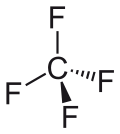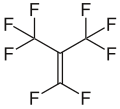Fluorocarbon
Fluorocarbon
Fluorocarbons, also known as perfluorocarbons or PFCs, are types of compounds that are made up of carbon and fluorine atoms. They are known for their stability, low reactivity, and ability to withstand high temperatures. Fluorocarbons are used in a variety of applications, including refrigeration, electronics, and medical imaging.
Chemical Structure[edit]
Fluorocarbons are composed of carbon and fluorine atoms. The carbon-fluorine bond is one of the strongest in organic chemistry, which contributes to the stability and low reactivity of these compounds. In a fluorocarbon, all hydrogen atoms present in a hydrocarbon are replaced by fluorine atoms.
Properties[edit]
Fluorocarbons are colorless, odorless gases or liquids that have a low boiling point and are nonflammable. They are also chemically stable and have low reactivity, which makes them suitable for use in a variety of applications. Fluorocarbons are also known for their high density and ability to withstand high temperatures.
Applications[edit]
Fluorocarbons are used in a wide range of applications. They are used as refrigerants in air conditioning and refrigeration systems, as well as in electronics for cooling and insulation. In the medical field, fluorocarbons are used in imaging techniques such as MRI and ultrasound. They are also used in the production of Teflon, a type of non-stick coating used in cookware.
Environmental Impact[edit]
While fluorocarbons have many useful applications, they also have a significant environmental impact. They are potent greenhouse gases, with a global warming potential much higher than that of carbon dioxide. They also contribute to the depletion of the ozone layer when they are released into the atmosphere.
See Also[edit]
|
|
|
-
Fluorocarbon
-
Tetrafluoromethane
-
Perfluorooctane
-
Perfluoro(2-methylpentane)
-
Perfluoro-1,3-dimethylcyclohexane
-
Perfluorodecaline
-
Halogenated gas concentrations 1978-present
-
Perfluoroisobutene
-
Tetrafluoroethylene
-
Hexafluoropropylene
-
Hexafluorobutyne
-
Hexafluorobenzene
Ad. Transform your life with W8MD's Budget GLP-1 injections from $75


W8MD offers a medical weight loss program to lose weight in Philadelphia. Our physician-supervised medical weight loss provides:
- Weight loss injections in NYC (generic and brand names):
- Zepbound / Mounjaro, Wegovy / Ozempic, Saxenda
- Most insurances accepted or discounted self-pay rates. We will obtain insurance prior authorizations if needed.
- Generic GLP1 weight loss injections from $75 for the starting dose.
- Also offer prescription weight loss medications including Phentermine, Qsymia, Diethylpropion, Contrave etc.
NYC weight loss doctor appointmentsNYC weight loss doctor appointments
Start your NYC weight loss journey today at our NYC medical weight loss and Philadelphia medical weight loss clinics.
- Call 718-946-5500 to lose weight in NYC or for medical weight loss in Philadelphia 215-676-2334.
- Tags:NYC medical weight loss, Philadelphia lose weight Zepbound NYC, Budget GLP1 weight loss injections, Wegovy Philadelphia, Wegovy NYC, Philadelphia medical weight loss, Brookly weight loss and Wegovy NYC
|
WikiMD's Wellness Encyclopedia |
| Let Food Be Thy Medicine Medicine Thy Food - Hippocrates |
Medical Disclaimer: WikiMD is not a substitute for professional medical advice. The information on WikiMD is provided as an information resource only, may be incorrect, outdated or misleading, and is not to be used or relied on for any diagnostic or treatment purposes. Please consult your health care provider before making any healthcare decisions or for guidance about a specific medical condition. WikiMD expressly disclaims responsibility, and shall have no liability, for any damages, loss, injury, or liability whatsoever suffered as a result of your reliance on the information contained in this site. By visiting this site you agree to the foregoing terms and conditions, which may from time to time be changed or supplemented by WikiMD. If you do not agree to the foregoing terms and conditions, you should not enter or use this site. See full disclaimer.
Credits:Most images are courtesy of Wikimedia commons, and templates, categories Wikipedia, licensed under CC BY SA or similar.
Translate this page: - East Asian
中文,
日本,
한국어,
South Asian
हिन्दी,
தமிழ்,
తెలుగు,
Urdu,
ಕನ್ನಡ,
Southeast Asian
Indonesian,
Vietnamese,
Thai,
မြန်မာဘာသာ,
বাংলা
European
español,
Deutsch,
français,
Greek,
português do Brasil,
polski,
română,
русский,
Nederlands,
norsk,
svenska,
suomi,
Italian
Middle Eastern & African
عربى,
Turkish,
Persian,
Hebrew,
Afrikaans,
isiZulu,
Kiswahili,
Other
Bulgarian,
Hungarian,
Czech,
Swedish,
മലയാളം,
मराठी,
ਪੰਜਾਬੀ,
ગુજરાતી,
Portuguese,
Ukrainian














